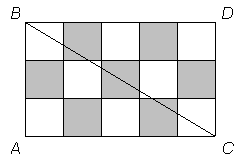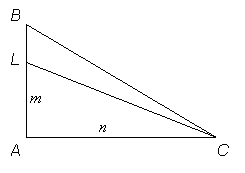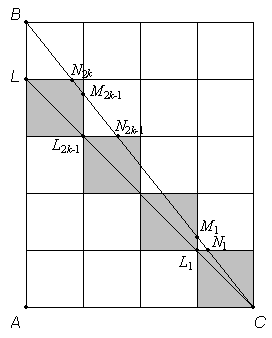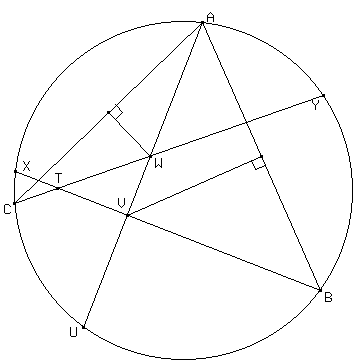
\ ..
Problem 1
(a) Let ABC be a right-angled triangle whose vertices have integer coordinates and whose legs lie along edges of the squares with <A=90o, AB=m and AC=n. Let us consider the mxn rectangle ABCD as shown in the figure.

For an arbitrary polygon P let us denote by S1(P) the total area of the black part of P and by S2(P) the total area of its white part.
When m and n are of the same parity the colouring of the rectangle ABCD is centrally symmetric about the midpoint of the hypotenuse BC. Hence S1(ABC) = S1(BCD) and S2(ABC) = S1(BCD). Therefore
f(m, n) = | S1(ABC) - S2(ABC) | = 1/2 | S1(ABCD) - S2(ABCD) |.
Hence f(m, n) = 0 for m, n both even and f(m, n) = 1/2 for m, n both odd.
(b) If m, n are both even or both odd the results follows from (a). Suppose now that m is odd and n is even. Consider a point L on AB such that AL = m -1 as shown below.
Since m - 1 is even we have f(m - 1, n) = 0, i.e., S1(ALC) = S2(ALC). Therefore
f(m, n) = | S1(ABC) - S2(ABC) | = | S1(LBC) - S2(LBC) |
![]() Area LBC = n/2
Area LBC = n/2 ![]() 1/2 max {m, n}
1/2 max {m, n}

(c) Let us compute f(2k + 1,2k). As in (b) we will consider a point L on AB such that AL = 2k. As f(2k, 2k) = 0 and S1(LBC) = S2(ALC) we have
f(2k + 1,2k) = | S1(LBC) - S2(LBC) |.
The area of the triangle LBC is k. Suppose without loss of generality that the diagonal LC is all black (see figure below). Then the white part of LBC consists of several triangles BLN2k, M2k-1L2k-1N2k-1, ... , M1L1N1, each of them being similar to BAC. Their total area is

![]() .
.
Therefore
![]()
and thus
![]()
This function takes arbitrarily large values.

Problem 2

Let us denote the diameters which are
perpendicular bisectors of AB and AC by b
and c respectively. Let us fix an orientation for arcs.
Then the notation ![]() PQ defines a unique
arc on the circle.
PQ defines a unique
arc on the circle.
Let X, Y be the second intersections of the circle with the lines BV and CW respectively. Then the chord CY is the mirror image of the chord AU in c.
Thus ![]() YC =
YC = ![]() AU. Similarly
AU. Similarly
![]() XB =
XB = ![]() AU. Then
AU. Then ![]() XB =
XB = ![]() YC and hence the
line segments BX and YC are symmetric with
respect to the diameter d which passes through the
midpoint of BY, with X being the mirror image
of C and Y being the mirror image of B.
YC and hence the
line segments BX and YC are symmetric with
respect to the diameter d which passes through the
midpoint of BY, with X being the mirror image
of C and Y being the mirror image of B.
As the point T lies on the line d, the perpendicular bisector of both BY and CX, we have TB = TY and TC = TX.
Then AU = BX = BT + TX = BT + CT.
Problem 3
For any permutation ![]() = ( y1,
y2, ... , yn )
of ( x1, x2, ... , xn
) denote by S(
= ( y1,
y2, ... , yn )
of ( x1, x2, ... , xn
) denote by S(![]() ) the value of the sum y1
+ 2y2 + ... + nyn.
Let r = (n + 1)/2. It has to be shown that |S(
) the value of the sum y1
+ 2y2 + ... + nyn.
Let r = (n + 1)/2. It has to be shown that |S(![]() )|
)| ![]() r for some
permutation
r for some
permutation ![]() .
.
Let ![]() 0 be the identity permutation
0 be the identity permutation ![]() 0
= ( x1, ... , xn
) and let
0
= ( x1, ... , xn
) and let ![]() be the reverse permutation
be the reverse permutation ![]() = ( xn
, ... , x1 ). If |S(
= ( xn
, ... , x1 ). If |S(![]() 0)|
0)| ![]() r or |S(
r or |S(![]() )|
)| ![]() r, the claim is
true. Assume for the sequel that |S(
r, the claim is
true. Assume for the sequel that |S(![]() 0)| > r and |S(
0)| > r and |S(![]() )| > r. Note that
)| > r. Note that
S(![]() 0) + S(
0) + S(![]() )
= ( x1 + 2x2 + ... + nxn
) + ( xn + 2xn-1
+ ... + nx1 ) = (n + 1)( x1
+ ... + xn ),
)
= ( x1 + 2x2 + ... + nxn
) + ( xn + 2xn-1
+ ... + nx1 ) = (n + 1)( x1
+ ... + xn ),
and hence | S(![]() 0) + S(
0) + S(![]() )
| = n + 1 = 2r. Since each one of the numbers S(
)
| = n + 1 = 2r. Since each one of the numbers S(![]() 0)
and S(
0)
and S(![]() ) exceeds r in absolute value,
they must have opposite signs. Accordingly, one of them is grater
than r and the other one is smaller than -r.
) exceeds r in absolute value,
they must have opposite signs. Accordingly, one of them is grater
than r and the other one is smaller than -r.
Starting from ![]() 0, we are
able to obtain any permutation by successive transpositions of
neighbouring elements. In particular, there exists a chain of
permutations
0, we are
able to obtain any permutation by successive transpositions of
neighbouring elements. In particular, there exists a chain of
permutations ![]() 0,
0, ![]() 1, ... ,
1, ... , ![]() m
such that
m
such that ![]() m =
m = ![]() and, for each i
and, for each i ![]() {0, ... , m-1}, the permutation
{0, ... , m-1}, the permutation
![]() i+1
arises from
i+1
arises from ![]() i by
interchanging two of its neighbouring terms.
i by
interchanging two of its neighbouring terms.
This means that if ![]() i
= ( y1 , ... , yn)
and
i
= ( y1 , ... , yn)
and ![]() i+1 = ( z1
, ... , zn), then there is an index k
i+1 = ( z1
, ... , zn), then there is an index k
![]() {1, ... , n - 1} such that
{1, ... , n - 1} such that
zk = yk+1
, zk+1 = yk
; zj
= yj for
j![]() k,
k + 1.
k,
k + 1.
And since the numbers xi do not exceed r in absolute value,
| S(![]() i+1)
- S(
i+1)
- S(![]() i) | = | kzk
+ (k + 1)zk+1 - kyk
(k + 1)yk+1 |
i) | = | kzk
+ (k + 1)zk+1 - kyk
(k + 1)yk+1 |
= | yk - yk+1
| ![]() | yk
| + | yk+1 |
| yk
| + | yk+1 | ![]() 2r.
2r.
This shows that the distance between any two
successive numbers in the sequence S(![]() 0), S(
0), S(![]() i)
, ... , S(
i)
, ... , S(![]() m) is not greater than
2r.
m) is not greater than
2r.
Recall that the numbers S(![]() 0)
and S(
0)
and S(![]() m), regarded as points
of the real line, lie putside the interval [-r, r],
on distinct sides of it. It follows that at least one of the
numbers S(
m), regarded as points
of the real line, lie putside the interval [-r, r],
on distinct sides of it. It follows that at least one of the
numbers S(![]() i) has to hit an
interval. Thus we have S(
i) has to hit an
interval. Thus we have S(![]() i)
i) ![]() r for a certain
r for a certain
![]() i, and the assertion is proved.
i, and the assertion is proved.
Problem 4
(a) Let n > 1 be an integer. Suppose that a silver n x n matrix A exists. Let x be a fixed element of {1, 2, ... , 2n -1} which does not appear on the diagonal of A. (Such an element exists, since there are only n elements on the diagonal but 2n - 1 elements in total.) The union of the ith row and the ith column we shall call it ith cross. The element x appears in each cross exactly once. If x is the (i , j)th entry of A, then it belongs to the ith cross and also to the jth cross. In this case we say that these crosses are x-linked. (For example, in the matrix A below the 1st and the 4th crosses are 6-linked.) This implies that all n crosses are partitioned into pairs of x-linked ones, and therefore n is even. But 1997 is an odd number.
(b) For n = 2
![]()
is a silver matrix. For n = 4 we have already several of them, for example
![matrix A 4x4 = [ 1 2 5 6 \ 3 1 7 5 \ 4 6 1 2 \ 7 4 3 1 ] , matrix B 4x4 = [ 1 2 4 5 \ 3 1 6 7 \ 7 5 1 3 \ 6 4 2 1 ]](solutions4_2.gif)
The construction of A can be generalized. Suppose that an n x n silver matrix exists. Then 2n x 2n silver matrix D can be constructed as follows:
![]()
where B is the n x n
matrix obtained from A by adding 2n to each
entry, and C is the matrix obtained from A by
adding 2n to each entry, and C is the matrix
obtained from B by replacing all its diagonal entries by
2n. This matrix will be again a silver matrix. To prove
this let us consider the ith cross of D.
Suppose that i ![]() n; the other case is similar.
This cross is composed of the ith cross of A,
the ith row of B and the ith column of
C. The ith cross of A contains numbers
{1, 2, ... , 2n -1}. The ith row of B
and the ith column of C together contain the
numbers {2n, 2n + 1 , ... , 4n - 1}.
n; the other case is similar.
This cross is composed of the ith cross of A,
the ith row of B and the ith column of
C. The ith cross of A contains numbers
{1, 2, ... , 2n -1}. The ith row of B
and the ith column of C together contain the
numbers {2n, 2n + 1 , ... , 4n - 1}.
Problem 5
Let a, b be a solution, let d be the greatest common divisor of a and b and let a = du, b = dv, with integers u, v being coprime, The given equation is equivalent to
| (du)dv2 = (dv)u. | (1) |
Comparing the exponents dv2 and u in (1), we distinguish three cases.
Case 1. dv2 = u. Then (1) implies u = v. Since u, v are coprime, we get u = v = 1; and dv2 = u yields d = 1. Hence a = b = 1, which is a solution.
Case 2. dv2 > u. Rewriting (1) as
| ddv2-u . udv2 = vu, | (2) |
we see that udv2 divides vu. Since u, v are coprime, u =1 and (2) becomes
| ddv2-1 = v. | (3) |
Now, if d =1 then by (3) v = 1 and the
inequality dv2 > u fails to hold.
And for d ![]() 2 we have
2 we have
ddv2-1
![]() 22v2-1
22v2-1
![]() 22v-1
> v for v = 1, 2, 3,
... ;
22v-1
> v for v = 1, 2, 3,
... ;
The last inequality is easily verified by induction on v. This contradicts (3) and shows that there are no solutions in this case.
Case 3. dv2 < u. (Hence u > d.) Rewriting (1) as
| udv2 = du-dv2 . vu, | (4) |
We see that vu divides udv2. Since u, v are coprime, v = 1 and (4) becomes
| ud = du-d. | (5) |
The exponentiation bases in (5) satisfy the inequality u > d; hence the exponents satisfy the opposite inequality d < u - d.
By (5), any prime divisor p is of d is also
a divisor of u. Taking y, z to be the
greatest exponents with py | u,
pz | d, we obtain from (5) yd
= z(u - d), which shows that y > z.
Thus d divides u, so u = kd or a
certain integer k. Note that k ![]() 3 because u>2d.
Substituting u = kd into (5), we get
3 because u>2d.
Substituting u = kd into (5), we get
| k = dk-2. | (6) |
It follows that d cannot be 1. Therefore d ![]() 2.
2.
If k = 3, then by (6) d = 3, whence u = 9, a = 27, b = 3.
If k = 4, then by (6) d2 = 4, whence d = 2, u = 8, a = 16, b = 2.
If k5, then dk-2
2k-2 > k (by easy induction) and (6) fails.
Thus, the equation has three solutions: (a, b) = (1, 1), (27, 3) and (16, 2).
Problem 6
If n = 2k + 1 is any odd integer greater than 1, then every representation of n in the given form has a "1" as one of its summands. Deleting we obtain a representation of the number 2k. And conversely, by attaching a "1" to a representation of 2k we obtain a representation of 2k + 1. The correspondence that results is obviously bijective. The recursion formula follows:
| f (2k + 1) = f (2k). | (1) |
Further, if n = 2k is any positive even integer, then every representation of n in the given form is one of the following two types: either it contains some terms equal to 1 or it does not contain such terms. In the first case we can delete one "1" to obtain a representation of 2k - 1: as before, we see that there is a bijection between the "first-type" representations of 2k and all representations of 2k - 1. In the case of a "second-type" representation (with no terms equal to 1), we can divide all its terms by 2 and obtain a representation of k; and also this correpondence is bijective. The second recursion formula follows:
| f (2k) = f (2k - 1) + f (k). | (2) |
Both of these formulae hold for any integer k![]() 1. Obviously, f(1) = 1. Let us
additionally define f(0) = 1; then the formula (1) holds
for k = 0 as well. It follows from (1) and (2) that the
function f is non-decreasing.
1. Obviously, f(1) = 1. Let us
additionally define f(0) = 1; then the formula (1) holds
for k = 0 as well. It follows from (1) and (2) that the
function f is non-decreasing.
According to (1), the number f(2k - 1) in the formula (2) can be replaced by f(2k - 2), yielding the equation
f (2k) - f (2k - 2) = f (k) for k = 1, 2, 3, ... .
Taking any integer n![]() 1 and summing these equations up over k
= 1 , ... , n, we obtain the following formula:
1 and summing these equations up over k
= 1 , ... , n, we obtain the following formula:
| f (2n) = f (0) + f (1) + ... + f(n) for n = 1, 2, 3, ... . | (3) |
We pass the two-sided estimation of the sequence ( f(2n):
n = 1, 2, 3, ... ). The upper estimate is easy: in the
formula (3) all the summands are not greater than the last one.
And since 2 = f(2) ![]() f(n) for n
f(n) for n![]() 2, we get
2, we get
f (2n) = 2 + ( f (2)
+ ... + f(n) ) ![]() 2 + (n - 1) f(n)
2 + (n - 1) f(n)
![]() f(n) + (n
- 1) f(n) = nf(n)
for n = 2, 3, 4, ... .
f(n) + (n
- 1) f(n) = nf(n)
for n = 2, 3, 4, ... .
Consequently,
f(2n) ![]() 2n-1
. f(2n-1)
2n-1
. f(2n-1) ![]() 2n-1 . 2n-2
. f(2n-2)
2n-1 . 2n-2
. f(2n-2) ![]() 2n-1 . 2n-2
. 2n-3 . f(2n-3)
2n-1 . 2n-2
. 2n-3 . f(2n-3)
![]() ...
... ![]() 2(n-1) + (n
-2) + ... + 1 . f(2) = 2n (n-1)/2
. 2.
2(n-1) + (n
-2) + ... + 1 . f(2) = 2n (n-1)/2
. 2.
And since 2n (n-1)/2
. 2 < 2n2/2
for n![]() 3, the upper estimate
results.
3, the upper estimate
results.
To work out the lower estimate, we first show that
| f (b + 1) - f(b)
|
(4) |
whenever b ![]() a
a ![]() 0 are integers of the same party. Indeed:
if a and b are both even, then in view of (1)
we have zeros on both sides of (4); and if a and b
are odd, then by (2) we get f(b + 1) - f(b)
= f( (b + 1)/2 ), f(a + 1) - f(a)
= f( (a + 1)/2 ) and the inequality in (4)
holds because the function f is non-decreasing.
0 are integers of the same party. Indeed:
if a and b are both even, then in view of (1)
we have zeros on both sides of (4); and if a and b
are odd, then by (2) we get f(b + 1) - f(b)
= f( (b + 1)/2 ), f(a + 1) - f(a)
= f( (a + 1)/2 ) and the inequality in (4)
holds because the function f is non-decreasing.
Let us take any integers r ![]() k
k ![]() 1, r even, and substitute
subsequently in (4) the numbers a = r - j, b = r +
j for j = 0, ... , k - 1. Then add the
inequalities that result, to obtain
1, r even, and substitute
subsequently in (4) the numbers a = r - j, b = r +
j for j = 0, ... , k - 1. Then add the
inequalities that result, to obtain
f (r + k) - f(r)
![]() f(r +
1) - f(r - k + 1).
f(r +
1) - f(r - k + 1).
Since r is even, we have f(r + 1) = f(r), and hence
f (r + k) + f(r
- k + 1) ![]() 2 f(r)
for k = 1, ... , r..
2 f(r)
for k = 1, ... , r..
Summing these inequalities up over k = 1 , ... , r we get
f(1) + f(2) + ... + f(2r)![]() 2r f(r).
2r f(r).
In view of (3) the sum on the left-hand side is equal to f(4r) - 1. Thus
f(4r) ![]() 2r f(r) + 1 > 2r
f(r) for every
integer r
2r f(r) + 1 > 2r
f(r) for every
integer r![]() 2.
2.
Taking r = 2m-2 we hence obtain
| f (2m) > 2m-1 f (2m-2). | (5) |
To ensure that r = 2m-2 is even, m ought to be an integer greater than 2; note, however, that (5) is also true for m = 2.
Finally, let n be any integer greater
than 1. If l is a positive integer such that 2l ![]() n, then applying
the inequality (5) for m = n, n-1, ...
, n - 2l + 2 we get
n, then applying
the inequality (5) for m = n, n-1, ...
, n - 2l + 2 we get
f (2n) > 2n-1 . f (2n-2) > 2n-1 . 2n-3 . f (2n-4) > 2n-1 . 2n-3 . 2n-5 . f (2n-6)
> ... > 2(n-1) + (n -3) + ... + (n - 2l + 1) . f (2n-2l) = 2l (n - l) . f (2n - 2l).
Now, if n is even, take l = n/2; and if n is odd, take l = (n - 1)/2. The resulting inequalities are:
f(2n) > 2n2/4 . f(20) = 2n2/4 for n even,
f(2n) > 2(n2 - 1)/4 . f(21) = 2(n2 - 1)/4 . 2 > 2n2/4 for n odd.
We have obtained the required lower estimate for
every integer n ![]() 2. (It is
also valid for n = 1, as can be verified directly.)
2. (It is
also valid for n = 1, as can be verified directly.)
feedbacks: webmaster@oma.org.ar